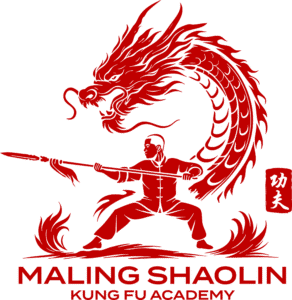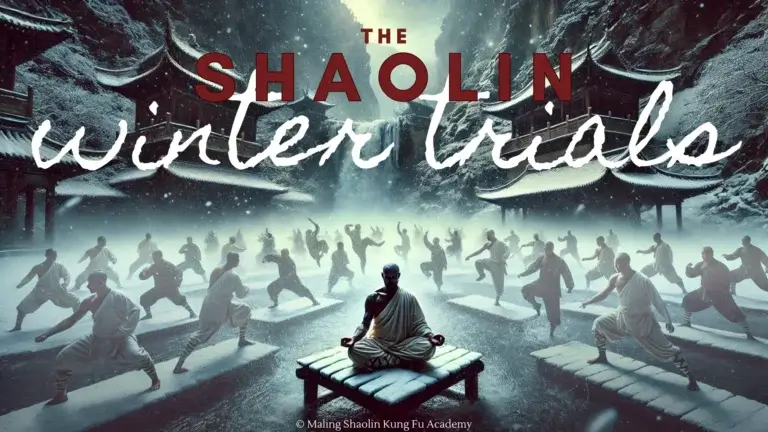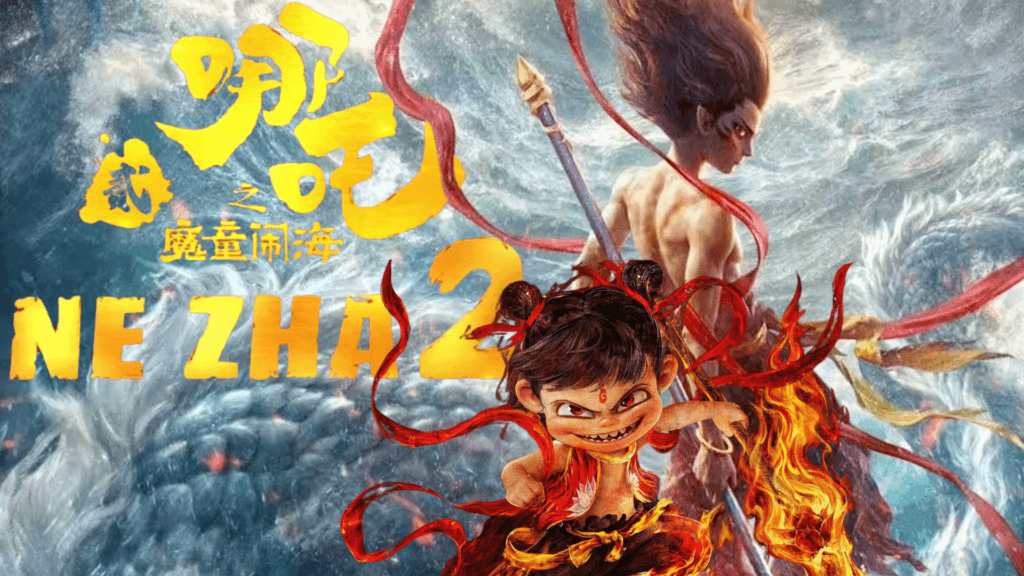
The legend of Ne Zha has been retold through various Chinese literary classics, religious traditions, and cultural depictions for centuries. In recent years, two major animated films—2019’s Ne Zha and 2025’s Ne Zha 2: Deep Sea Ne Zha—have redefined how the character is portrayed, modernizing his story for a new generation. With groundbreaking animation, high-energy martial arts, and a reinterpretation of Chinese mythology, these films have not only dominated the Chinese box office but also gained international recognition.
These movies blend traditional Chinese folklore with modern storytelling techniques, bringing fresh layers of complexity to the character and his world. Beyond their stunning visuals and action, they explore themes of fate, personal struggle, and redemption, making Ne Zha’s story resonate with audiences both in China and abroad. This article will take a deep dive into the story, historical and literary origins, martial arts influences, and the cultural impact of these cinematic portrayals of Ne Zha.
The Story of Ne Zha Across Two Films
The 2019 animated film Ne Zha was a record-breaking success, reinterpreted Ne Zha’s legend with a rebellious and misunderstood protagonist fighting against fate. The newly released 2025 sequel, Deep Sea Ne Zha, continues this theme, pushing animation to new artistic heights while further developing Ne Zha’s journey of self-discovery.
As of March 2025, Ne Zha 2, Deep Sea Ne Zha, has shattered multiple box office records, cementing itself as a landmark achievement in global cinema. This Chinese animated epic has not only become the highest-grossing film of all time in China, but it has also overtaken Pixar’s Inside Out 2 to claim the title of the highest-grossing animated film worldwide. In doing so, Ne Zha 2 has made history as the first non-English language film to surpass $1 billion at the global box office and the first non-Hollywood production to crack the all-time top 10 highest-grossing films worldwide.
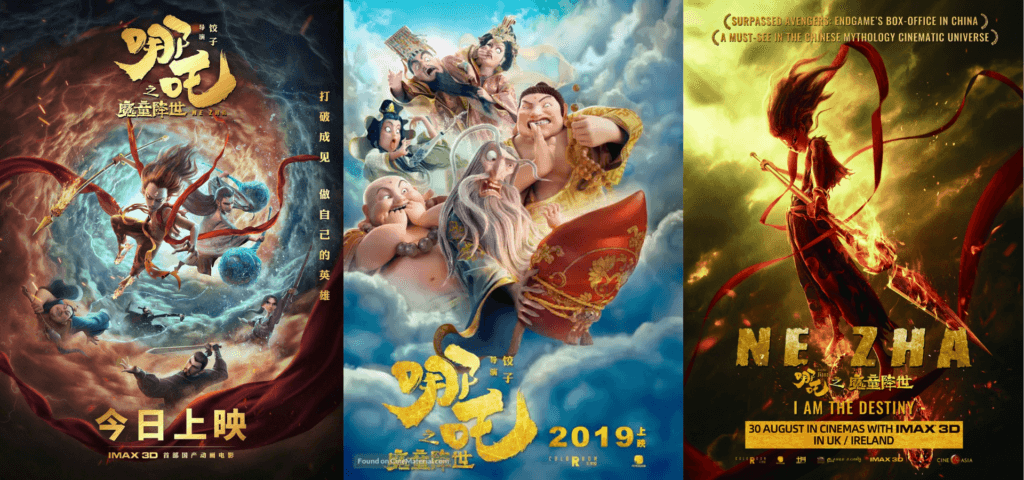
2019’s Ne Zha: A Hero Fighting Fate
In this reimagining, Ne Zha is not the chosen one but instead a victim of a cosmic accident. The Primordial Pearl, a celestial artifact meant to create a great hero, is split into two parts:
- The Spirit Pearl, which was destined to be reincarnated into a noble warrior.
- The Demon Pearl, filled with chaotic energy, mistakenly infused into Ne Zha before birth.
Ne Zha, born into a village that fears him, struggles with isolation, anger, and his own destructive impulses. He eventually learns that he is destined to die in three years due to a celestial curse. Rather than succumbing to this fate, he chooses his own path, rejecting his demonic nature and embracing heroism.
Alongside Ao Bing, the Dragon Prince born from the Spirit Pearl, Ne Zha challenges the heavens and fights against the rigid structures of predetermined destiny. His story becomes one of self-determination and overcoming prejudice, making the character deeply relatable beyond his mythological roots.

2025’s Deep Sea Ne Zha: A Grander Mythological Expansion
In Deep Sea Ne Zha, the story delves deeper into the connections between Ne Zha, the Dragons, and the Heavens. This sequel features more cosmic-scale battles, exploring Ne Zha’s evolution from a rebellious outcast to a celestial warrior. The animation takes inspiration from traditional Chinese ink wash paintings, blending them with cutting-edge CGI to create visually breathtaking action sequences.
This film also introduces new divine and demonic beings, expanding the mythos and delving into themes of reincarnation, karma, and redemption.
Ne Zha in Chinese History and Literature

The Mythological Origins of Ne Zha
Ne Zha is a complex figure in Chinese mythology, appearing in several classical texts, each with varying interpretations of his origin and character. His story has been deeply embedded in Daoist and Buddhist traditions, often serving as a symbol of rebellion against fate and divine hierarchy.
His first major appearance is in the 16th-century novel Fengshen Yanyi (Investiture of the Gods), one of the Four Great Classical Novels of Chinese mythology. In this text:
- Ne Zha is the son of Li Jing, a military commander, and is born with supernatural strength.
- He slays a sea dragon prince, enraging the Dragon Kings of the Four Seas.
- To atone for this act, he sacrifices himself by flaying his own flesh and is later resurrected by Daoist master Taiyi Zhenren with a new lotus body.
- He returns as a warrior, riding flaming wheels, and fights against both earthly and celestial forces.
In addition to his major role in Fengshen Yanyi (Investiture of the Gods), Ne Zha also appears in Wu Cheng’en’s Journey to the West, one of the most famous and influential works of Chinese literature. While he plays a smaller role in this story compared to Fengshen Yanyi, Ne Zha’s powerful combat skills and divine status make him a significant presence.
Ne Zha appears early in Journey to the West as a general in the service of the Jade Emperor, the ruler of the heavens. He is sent to subdue Sun Wukong (the Monkey King) after the rebellious monkey defies celestial authority and declares himself the “Great Sage Equal to Heaven.” Ne Zha engages Wukong in battle, demonstrating his martial prowess but, despite his formidable skills, he is ultimately unable to defeat Wukong, who proves to be an exceptionally powerful opponent. Their duel becomes one of the many iconic confrontations in the novel.
Although Ne Zha does not play a major recurring role throughout the journey of Tang Sanzang and his disciples, his presence in Journey to the West further cements his status as one of the great warriors of Chinese mythology, standing alongside celestial generals, deities, and legendary figures like Erlang Shen and Guan Yu.

Ne Zha’s Role in Chinese Religious Practices
Ne Zha is worshiped as a protective deity in Buddhism, Daoism, and Chinese folk religion. In Daoist tradition, he is associated with:
- Guarding temple gates against demons.
- Protecting travelers and warriors.
- Symbolizing defiance against unjust authority.
In Buddhism, Ne Zha is sometimes linked to Skanda (Weituo), a guardian of Buddhist teachings. This dual influence reinforces his status as a warrior who fights for righteousness while struggling with his own identity.
Other Mythological Figures in the Films
- Ao Bing (Dragon Prince) – Traditionally a villain in Ne Zha’s legend, Ao Bing is reinterpreted in modern films as a tragic hero seeking redemption.
- Taiyi Zhenren – Ne Zha’s Daoist master, portrayed humorously in the films, is an important Daoist immortal known for his alchemy and spiritual teachings.
- Shen Gongbao – A celestial trickster who challenges the hierarchy of gods, representing the danger of ambition without wisdom.
Martial Arts in Ne Zha: A Fusion of Wushu and Fantasy Combat
The action choreography in Ne Zha is deeply rooted in traditional Chinese martial arts (Wushu) while integrating fantasy elements to create spectacular fight sequences.
Martial Arts Styles Represented
- Changquan (Long Fist) – Ne Zha’s agile, acrobatic fighting style draws from this Northern Shaolin style, emphasizing fast, flowing movements.
- Bagua Zhang (Eight Trigram Palm) – Ao Bing’s circular dodging and redirection techniques resemble this internal martial art, which focuses on evasive movements and counterattacks.
- Drunken Fist (Zui Quan) – Taiyi Zhenren, Ne Zha’s master, fights with an exaggerated, unpredictable drunken style, reflecting both humor and hidden skill.
Weapons and Mythological Techniques
- Ne Zha’s Fire-Tipped Spear (火尖枪) – Inspired by traditional Chinese spear combat, combining thrusts, spins, and aerial attacks.
- Wind Fire Wheels (风火轮) – Symbolic of Ne Zha’s divine speed, used in aerial combat similar to Wing Chun’s footwork techniques.
- Ao Bing’s Water Manipulation – Blending internal energy control (Qi) with Daoist elemental combat, making him a formidable opponent.
Cultural and Global Impact
China: A Landmark for Animation
- Ne Zha (2025) became the highest-grossing animated film ever, breaking cultural, global, and cinematic records.
- It revolutionized Chinese animation, proving that domestic animated films could compete with Hollywood productions.
International Recognition
- Ne Zha 1 and 2 were widely released in the U.S. and Europe, marking a turning point for Chinese animation on the world stage.
- Critics praised its emotional depth, humor, and martial arts choreography, bridging Eastern mythology with universal storytelling.
Ne Zha’s Increasing Presence in Modern Films
In recent years, Ne Zha has experienced a resurgence in Chinese cinema, appearing in multiple films that reimagine his character in both animated and live-action formats. Traditionally depicted as a rebellious warrior with divine powers, fire wheels, and a spear, Ne Zha has long been a central figure in Chinese mythology. However, modern filmmakers have reinterpreted his story, making him a symbol of individualism, defiance against fate, and personal transformation.
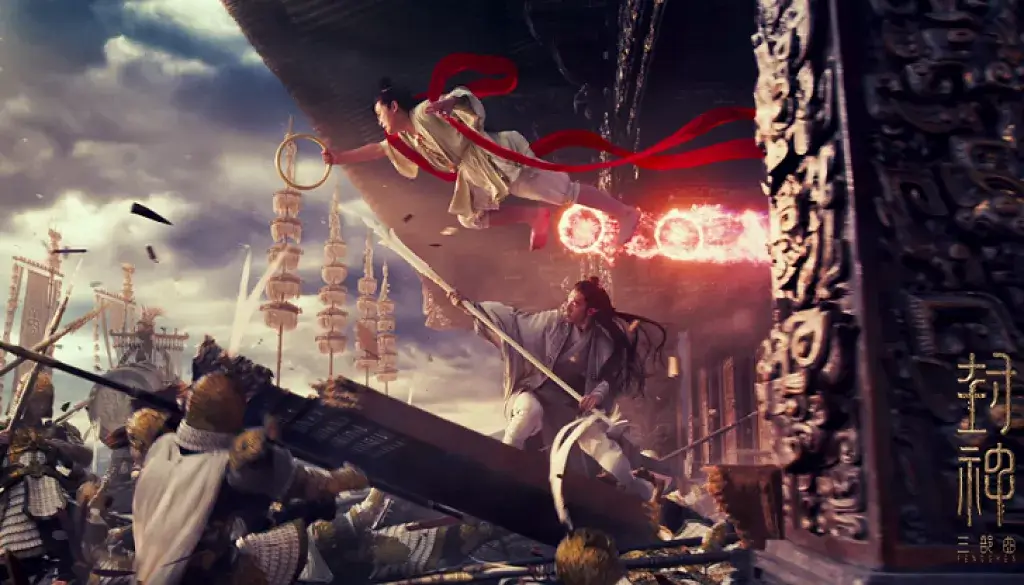
Ne Zha in “Creation of the Gods I: Kingdom of Storms” (2023)
Unlike previous adaptations where Ne Zha is depicted as a solitary figure, Creation of the Gods I places him within a larger mythological conflict, fighting alongside other legendary warriors. In this film:
- Ne Zha retains his youthful yet fierce personality, showcasing his iconic Wind Fire Wheels and Fire-Tipped Spear in stunningly choreographed battle sequences.
- His role is expanded within the larger political and supernatural struggles of ancient China, emphasizing his rebellious yet honorable nature.
- The film received critical acclaim for its faithful yet modernized adaptation of the mythology, impressive cinematography, and intense battle choreography.
Given the success of the first COG film, Ne Zha is expected to appear in future installments of the trilogy. His journey will likely evolve further as the story progresses, continuing his legacy as a warrior who defies fate and fights for justice.
Other Recent Films Featuring Ne Zha
In addition to Creation of the Gods I, Ne Zha has appeared in several recent animated adaptations that have reshaped how audiences view his legend:
- Ne Zha’s Voyage Beyond (2023) – This whimsical adventure sees Ne Zha embarking on an epic journey across uncharted realms, introducing new allies and formidable foes, all while reaffirming his determination to forge his own path.
- Ne Zha and the Jade Warrior (2022) – A visually stunning tale that teams Ne Zha with an enigmatic new hero, this film balances thrilling action sequences with a heartwarming narrative of friendship and trust.
- New Gods: Nezha Reborn (2021) – A cyberpunk-inspired reimagining of Ne Zha, this film placed him in a futuristic setting, merging mythology with modern action storytelling.
Bonus: Ne Zha’s Appearance in Black Myth: Wukong the Video Game
Released in August 2024, Black Myth: Wukong achieved remarkable success, selling over 10 million copies within three days and surpassing 20 million units in its first month, making it one of the fastest-selling games in history. Developed by Game Science, this action RPG brings the world of Journey to the West to life with stunning visuals and Souls-like combat mechanics.
While Ne Zha is not a central character in Black Myth: Wukong, he reportedly makes a brief but impactful appearance at the end of the game, hinting at a larger interconnected mythological universe. His presence suggests that future expansions, sequels, or additional content may further explore his character, allowing players to engage with one of China’s most legendary warriors in a modern gaming format.
The Future of Ne Zha in Cinema
With Creation of the Gods I proving that live-action adaptations of Chinese mythology can achieve critical and commercial success, and the 2019 and 2025 global success of Ne Zha movies, Ne Zha’s continued presence in future films is almost guaranteed. Whether through traditional retellings, animated reimaginings, or modernized versions, his story continues to evolve, proving his timeless relevance in both Chinese culture and global storytelling.
As the “Creation of the Gods” trilogy progresses, audiences can expect Ne Zha’s character development to deepen, further solidifying his role as one of China’s most enduring mythological heroes.
Conclusion
The Ne Zha films have breathed new life into Chinese mythology, martial arts, and animation, reshaping the legend for modern audiences. More than just commercial successes, they have introduced Chinese cultural heritage to the global stage, proving that compelling storytelling transcends borders. By fusing historical roots, high-energy combat, and stunning animation, Ne Zha has become a cultural movement, setting a new standard for Chinese cinema. As audiences continue to embrace mythology-inspired storytelling, the legacy of Ne Zha is bound to influence future generations of filmmakers and animators worldwide.
